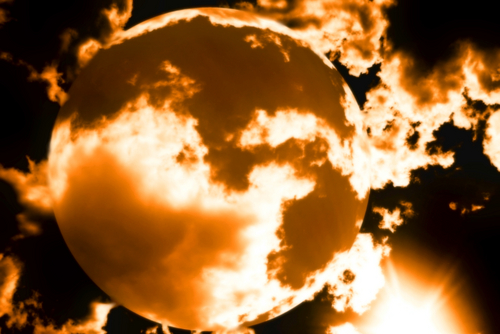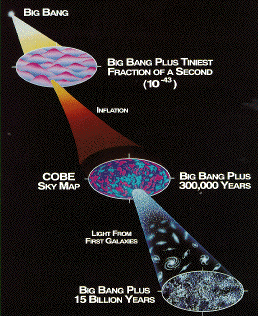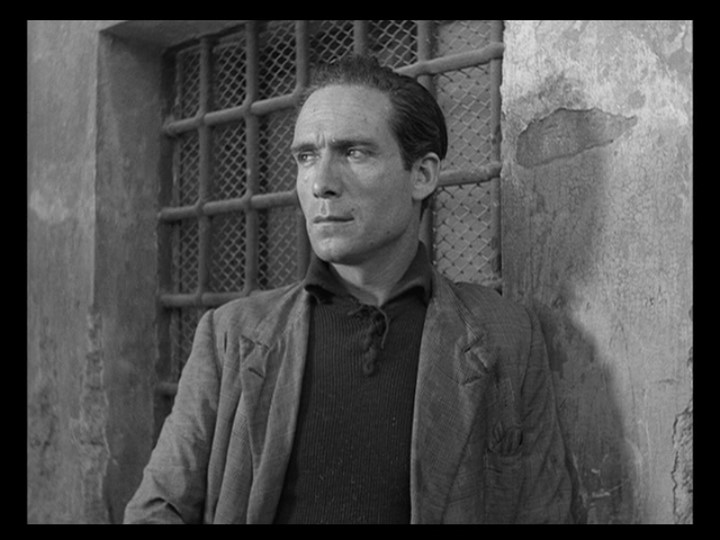
THE BIG BANG:
The Hubble Telescope's deepest view of the universe teaches us about the beginning
INTRODUCTION
We certainly know that our universe exists, however, this knowledge alone has not satisfied mankind's quest for further understanding. Our curiosity has led us to question our place in this universe and furthermore, the place of the universe itself. Throughout time we have asked ourselves these questions: How did our universe begin? How old is our universe? How did matter come to exist? Obviously, these are not simple questions and throughout our brief history on this planet much time and effort has been spent looking for some clue. Yet, after all this energy has been expended, much of what we know is still only speculation.
We have, however, come a long way from the mystical beginnings of the study of cosmology and the origins of the universe. Through the understandings of modern science we have been able to provide firm theories for some of the answers we once called hypotheses. True to the nature of science, a majority of these answers have only led to more intriguing and complex questions. It seems to be inherent in our search for knowledge that questions will always continue to exist.
Although in this short chapter it will be impossible to tackle all of the questions concerning the creation of everything we know as reality, an attempt will be made to address certain fundamental questions of our being. It will be important to keep in mind that all of this information is constantly being questioned and reevaluated in order to understand the universe more clearly. For our purposes, through an examination of what is known about the Big Bang itself, the age of the universe, and the synthesis of the first atoms, we believe that we can begin to answer several of these key questions.
THE BIG BANG
One of the most persistently asked questions has been: How was the universe created? Many once believed that the universe had no beginning or end and was truly infinite. Through the inception of the Big Bang theory, however,no longer could the universe be considered infinite. The universe was forced to take on the properties of a finite phenomenon, possessing a history and a beginning.
About 15 billion years ago a tremendous explosion started the expansion of the universe. This explosion is known as the Big Bang. At the point of this event all of the matter and energy of space was contained at one point. What exisisted prior to this event is completely unknown and is a matter of pure speculation. This occurance was not a conventional explosion but rather an event filling all of space with all of the particles of the embryonic universe rushing away from each other. The Big Bang actually consisted of an explosion of space within itself unlike an explosion of a bomb were fragments are thrown outward. The galaxies were not all clumped together, but rather the Big Bang lay the foundations for the universe.
The origin of the Big Bang theory can be credited to Edwin Hubble. Hubble made the observation that the universe is continuously expanding. He discovered that a galaxys velocity is proportional to its distance. Galaxies that are twice as far from us move twice as fast. Another consequence is that the universe is expanding in every direction. This observation means that it has taken every galaxy the same amount of time to move from a common starting position to its current position. Just as the Big Bang provided for the foundation of the universe, Hubbles observations provided for the foundation of the Big Bang theory.
Since the Big Bang, the universe has been continuously expanding and, thus, there has been more and more distance between clusters of galaxies. This phenomenon of galaxies moving farther away from each other is known as the red shift. As light from distant galaxies approach earth there is an increase of space between earth and the galaxy, which leads to wavelengths being stretched.
In addition to the understanding of the velocity of galaxies emanating from a single point, there is further evidence for the Big Bang. In 1964, two astronomers, Arno Penzias and Robert Wilson, in an attempt to detect microwaves from outer space, inadvertently discovered a noise of extraterrestrial origin. The noise did not seem to emanate from one location but instead, it came from all directions at once. It became obvious that what they heard was radiation from the farthest reaches of the universe which had been left over from the Big Bang. This discovery of the radioactive aftermath of the initial explosion lent much credence to the Big Bang theory.
 Even more recently, NASAs COBE satellite was able to detect cosmic microwaves eminating from the outer reaches of the universe. These microwaves were remarkably uniform which illustrated the homogenity of the early stages of the universe. However, the satillite also discovered that as the universe began to cool and was still expanding, small fluctuations began to exist due to temperature differences. These flucuatuations verified prior calculations of the possible cooling and development of the universe just fractions of a second after its creation. These fluctuations in the universe provided a more detailed description of the first moments after the Big Bang. They also helped to tell the story of the formation of galaxies which will be discussed in the next chapter.
Even more recently, NASAs COBE satellite was able to detect cosmic microwaves eminating from the outer reaches of the universe. These microwaves were remarkably uniform which illustrated the homogenity of the early stages of the universe. However, the satillite also discovered that as the universe began to cool and was still expanding, small fluctuations began to exist due to temperature differences. These flucuatuations verified prior calculations of the possible cooling and development of the universe just fractions of a second after its creation. These fluctuations in the universe provided a more detailed description of the first moments after the Big Bang. They also helped to tell the story of the formation of galaxies which will be discussed in the next chapter.
The Big Bang theory provides a viable solution to one of the most pressing questions of all time. It is important to understand, however, that the theory itself is constantly being revised. As more observations are made and more research conducted, the Big Bang theory becomes more complete and our knowledge of the origins of the universe more substantial.
THE FIRST ATOMS
Now that an attempt has been made to grapple with the theory of the Big Bang, the next logical question to ask would be what happened afterward? In the minuscule fractions of the first second after creation what was once a complete vacuum began to evolve into what we now know as the universe. In the very beginning there was nothing except for a plasma soup. What is known of these brief moments in time, at the start of our study of cosmology, is largely conjectural. However, science has devised some sketch of what probably happened, based on what is known about the universe today.
Immediately after the Big Bang, as one might imagine, the universe was tremendously hot as a result of particles of both matter and antimatter rushing apart in all directions. As it began to cool, at around 10^-43 seconds after creation, there existed an almost equal yet asymmetrical amount of matter and antimatter. As these two materials are created together, they collide and destroy one another creating pure energy. Fortunately for us, there was an asymmetry in favor of matter. As a direct result of an excess of about one part per billion, the universe was able to mature in a way favorable for matter to persist. As the universe first began to expand, this discrepancy grew larger. The particles which began to dominate were those of matter. They were created and they decayed without the accompaniment of an equal creation or decay of an antiparticle.
As the universe expanded further, and thus cooled, common particles began to form. These particles are called baryons and include photons, neutrinos, electrons and quarks would become the building blocks of matter and life as we know it. During the baryon genesis period there were no recognizable heavy particles such as protons or neutrons because of the still intense heat. At this moment, there was only a quark soup. As the universe began to cool and expand even more, we begin to understand more clearly what exactly happened.
After the universe had cooled to about 3000 billion degrees Kelvin, a radical transition began which has been likened to the phase transition of water turning to ice. Composite particles such as protons and neutrons, called hadrons, became the common state of matter after this transition. Still, no matter more complex could form at these temperatures. Although lighter particles, called leptons, also existed, they were prohibited from reacting with the hadrons to form more complex states of matter. These leptons, which include electrons, neutrinos and photons, would soon be able to join their hadron kin in a union that would define present-day common matter.
After about one to three minutes had passed since the creation of the universe, protons and neutrons began to react with each other to form deuterium, an isotope of hydrogen. Deuterium, or heavy hydrogen, soon collected another neutron to form tritium. Rapidly following this reaction was the addition of another proton which produced a helium nucleus. Scientists believe that there was one helium nucleus for every ten protons within the first three minutes of the universe. After further cooling, these excess protons would be able to capture an electron to create common hydrogen. Consequently, the universe today is observed to contain one helium atom for every ten or eleven atoms of hydrogen.
While it is true that much of this information is speculative, as the universe ages we are able to become increasingly confident in our knowledge of its history. By studying the way in which the universe exists today it is possible to learn a great deal about its past. Much effort has gone into understanding the formation and number of baryons present today. Through finding answers to these modern questions, it is possible to trace their role in the universe back to the Big Bang. Subsequently, by studying the formation of simple atoms in the laboratory we can make some educated guesses as to how they formed originally. Only through further research and discovery will it be possible to completely understand the creation of the universe and its first atomic structures, however, maybe we will never know for sure.



 Even more recently, NASAs COBE satellite was able to detect cosmic microwaves eminating from the outer reaches of the universe. These microwaves were remarkably uniform which illustrated the homogenity of the early stages of the universe. However, the satillite also discovered that as the universe began to cool and was still expanding, small fluctuations began to exist due to temperature differences. These flucuatuations verified prior calculations of the possible cooling and development of the universe just fractions of a second after its creation. These fluctuations in the universe provided a more detailed description of the first moments after the Big Bang. They also helped to tell the story of the formation of galaxies which will be discussed in the next chapter.
Even more recently, NASAs COBE satellite was able to detect cosmic microwaves eminating from the outer reaches of the universe. These microwaves were remarkably uniform which illustrated the homogenity of the early stages of the universe. However, the satillite also discovered that as the universe began to cool and was still expanding, small fluctuations began to exist due to temperature differences. These flucuatuations verified prior calculations of the possible cooling and development of the universe just fractions of a second after its creation. These fluctuations in the universe provided a more detailed description of the first moments after the Big Bang. They also helped to tell the story of the formation of galaxies which will be discussed in the next chapter. 





















